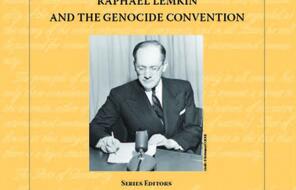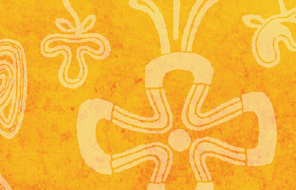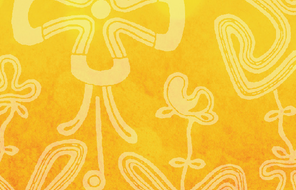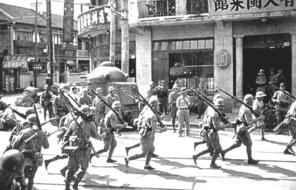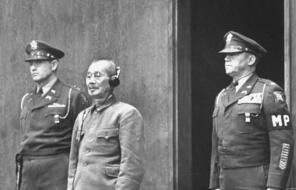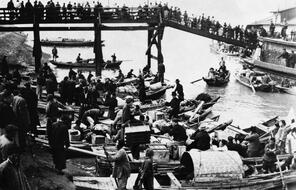“Sovereignty cannot be conceived as the right to kill millions”
At a Glance
Language
English — USSubject
- History
- Genocide
They were a respected couple. The man, known as Said Ali Bey, was dignified, highly educated, and thought to be very rich; his wife was an attractive, modern Muslim woman with refined tastes and an independent mind. 1 They were Turkish and had come to Berlin three years earlier, at the end of World War I. Their neighbors often saw them strolling together after dinner.
On the evening of March 15, 1921, they were walking in the elegant Charlottenburg district when a young Armenian man came up to Bey and tapped him on the shoulder. He then drew a revolver and shot both of them, hitting Bey in the head, killing him at once and wounding his wife. Passersby who had seen the murder immediately seized the young man and came close to lynching him on the spot. 2 When the police arrived, the assassin pointed at the man he had shot and declared, “It is not I who am the murderer. It is he!” 3
Soon the whole world learned what this puzzling statement meant and who the two men were. The young Armenian, Soghomon Tehlirian, said the man he had killed was not Said Ali Bey. His real name was Mehmed Talaat, and he had been the minister of the interior of the Ottoman Empire (now Turkey). During World War I, Talaat, who was known as the “Big Boss,” had conducted a ruthless campaign against the Armenian people, a Christian minority in the empire. At his trial, Tehlirian described the events he had seen in his own town:
In 1915 the Armenian populace of Erzerum was suddenly alarmed by the news that the Turkish Government planned violent measures. Shortly afterward the populace was herded together and driven off in columns under the conduct of Turkish soldiers. After being robbed of their money and belongings[,] the massacre, in which my family were victims, took place. After I had seen my brother’s skull split, I was hit on the head and lay unconscious probably [for] one or two days. 4
Evidence presented at Tehlirian’s trial showed that in 1915 alone, Talaat had “presided over the killing by firing squad, bayoneting, bludgeoning, and starvation of nearly 1 million Armenians.” 5 The plans had been methodically drawn up and carried out. First the Armenian leadership was murdered. Then Armenian men of military age were driven from their villages and either immediately executed or sent to death camps. Then the children, women, and old men were evicted from their homes and forced to make death marches, during which special units attacked them, butchering tens of thousands of people. Those who survived the rapes, the beatings, the murderous attacks, and the hardships of the marches were sent to the desert to die of thirst and hunger. 6 Germany had been an ally of the Ottoman Empire in World War I. During Tehlirian’s trial, it was also revealed that despite the terrible crimes committed by Talaat and his subordinates, the German government had sheltered him and other Ottoman leaders after the war. In Germany, they had enjoyed the comfortable and respectable lives of retired state officials. 7
✳ ✳ ✳
Raphael Lemkin, a young Polish Jew who had recently begun studying at the University of Lvov, read about Tehlirian’s trial in the newspaper. Horrified, he talked with one of his professors about the case. He asked whether Tehlirian had tried to have Talaat arrested for the massacre of the Armenians before deciding to shoot him himself.
His professor shook his head and stated the awful truth about the lack of international laws to try perpetrators of state-sanctioned crimes: “There was no law under which he [Talaat] could be arrested. . . . Consider the case of a farmer who owns a flock of chickens. He kills them, and this is his business. If you interfere, you are trespassing.”
Lemkin was shocked. “But the Armenians are not chickens. Certainly—” The professor coolly went on, “You cannot interfere with the internal affairs of a nation without infringing on that nation’s sovereignty.”
To Lemkin, this did not make sense. “It is a crime for Tehlirian to kill a man, but it is not a crime for his oppressor to kill more than a million men. This is most inconsistent.” 8 But Lemkin’s professor simply stated facts: After World War I, when the victorious states sought to charge Turkey and Germany for crimes they committed against their own citizens, they had no law on which to rely. While war crimes were already defined by the international community, no agreement on crimes such as the ones the Ottoman Empire perpetrated against its Armenian citizens was in existence. 9
Tehlirian was eventually acquitted on the grounds of temporary insanity, but Lemkin remained haunted by the case. How could the world ignore the fact that known murderers were living happily in democratic nations? Lemkin began to study the background of the Talaat case. He learned that after World War I, a Turkish court had actually found Talaat and other Ottoman leaders guilty of mass murder and had sentenced them to death. But he also discovered that many of these condemned officials, including Talaat, had fled before their sentences could be carried out; the others had been released. 10 Was it really possible that nearly everyone responsible for one of the greatest massacres in history had escaped without any consequences?
The more he learned about the Armenian massacre and what had happened after it, the more outraged Lemkin felt. He could not accept the idea that a man could be punished if he killed another man, but a man who had killed millions could not be prosecuted for this crime. In his autobiography, Lemkin asked, “Why was killing a million people a less serious crime than killing a single individual?” 11 The two things were completely contradictory.
It seemed clear to Lemkin that the ideal of sovereignty described by his professor—a nation’s right to determine what happens to its citizens and within its borders—should not be used as a shield for nations that persecuted and murdered their own people. He thought that sovereignty should be redefined to mean all the things a nation does for the benefit of its own people—such things as conducting relationships with other countries as well as internal activities like building schools and roads. But, he said, “Sovereignty cannot be conceived as the right to kill millions of innocent people.” 12
To cure the illness of a world where men like Talaat went free, strong medicine was needed. Lemkin soon came to believe that the cure for mass murder and gross abuses of human rights would have to come through international law. But he discovered that very few international laws existed to deal with such crises. In addition, no international court had jurisdiction over crimes committed within a sovereign nation’s borders. This seemed wrong to Lemkin, and he began to think about how it could be changed.
- 1“Talaat is Mourned as Germany’s Friend,” New York Times, March 18, 1921.
- 2“Talaat Pasha Slain in Berlin Suburb,” New York Times, March 16, 1921.
- 3“Assassin Boasts of Talaat’s Death,” New York Times, March 17, 1921.
- 4“Says Mother’s Ghost Ordered Him to Kill,” New York Times, June 3, 1921.
- 5Samantha Power, “A Problem from Hell”: America and the Age of Genocide (New York: Basic Books, 2002), 1.
- 6Details about the Armenian Genocide can be found in Facing History’s resource book entitled Crimes Against Humanity and Civilization: The Genocide of the Armenians (Brookline: Facing History and Ourselves, 2004).
- 7J. Michael Hagopian’s documentary Germany and the Secret Genocide, VHS (Thousand Oaks: Armenian Film Foundation, 2003) discusses the involvement of Germany (Turkey’s wartime ally) in the Armenian Genocide.
- 8Robert Merrill Bartlett, They Stand Invincible: Men Who Are Reshaping Our World (New York: Thomas Y. Crowell Company, 1959), 96-97. The story is also vividly told by Power in A Problem from Hell, 17.
- 9Taner Akçam, From Empire to Republic: Turkish Nationalism and the Armenian Genocide (New York: Zed Books, 2004) 185-90.
- 10For details on these trials, see Gary Jonathan Bass, Stay the Hand of Vengeance: The Politics of War Crimes Tribunals (Princeton: Princeton University Press, 2000), 106-46. On Lemkin’s reaction to the trials, see Steven L. Jacobs, “Raphael Lemkin and the Armenian Genocide,” in Looking Backward, Moving Forward: Confronting the Armenian Genocide, ed. Richard G. Hovannisian (New Brunswick: Transaction Publishers, 2003), 127.
- 11Raphael Lemkin, Totally Unofficial Man: The Autobiography of Raphael Lemkin, in Pioneers of Genocide Studies, ed. Steven L. Jacobs and Samuel Totten (New Brunswick: Transaction Books, 2002), 371.
- 12Ibid.
How to Cite This Reading
Facing History & Ourselves, ""Sovereignty cannot be conceived as the right to kill millions"," last updated March 16, 2008, https://www.facinghistory.org/.
This reading contains text not authored by Facing History & Ourselves. See footnotes for source information.

